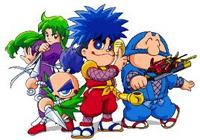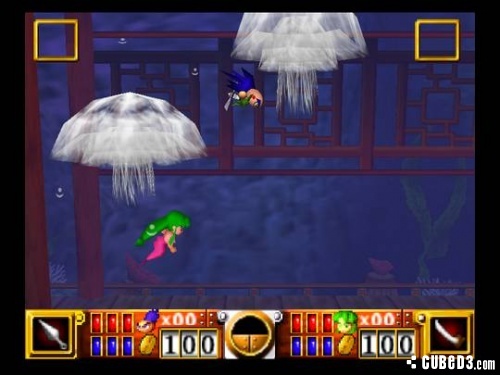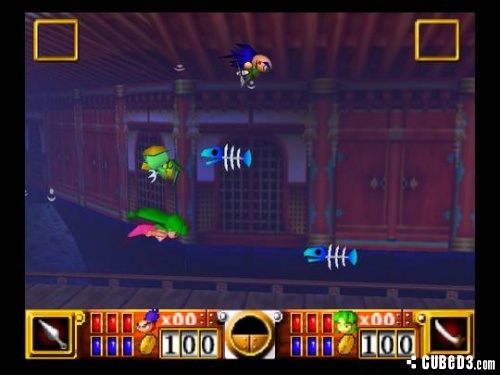Mystical Ninja 2 Starring Goemon (Nintendo 64) Review
By Rudy Lavaux  13.03.2012
13.03.2012

As Cubed3 has reported several times in the past, the Ganbare Goemon franchise is a strong one in its home country of Japan. Referred to in Western territories as the Mystical Ninja series, it saw only a handful of releases in North America and Europe. Once a saga that was very much centered around Nintendo consoles, it started to venture to pastures new after the December 1995 release of Ganbare Goemon: Kirakira Douchuu: Boku ga Dancer ni Natta Wake on the Super Famicom, starting with Ganbare Goemon: Uchuu Kaizoku Akogingu in March 1996 for the PlayStation. Unlike other publishers that ditched Nintendo in that era, Konami only partially sided with Sony. The PlayStation received four mainline episodes, but the Nintendo 64 not only got two of the most highly regarded ‘mothership’ titles, and a party game spin-off, but the first two of those where even released outside Japan, unlike the Sony releases. More than thirty titles have been made, only five of which have reached Western shores, two being for the 64-bit console. As part of the Nintendo 64’s 15th anniversary celebrations, Cubed3 reviews the second one, Mystical Ninja 2 Starring Goemon, also known to American readers as Goemon's Great Adventure, the sequel to Mystical Ninja Starring Goemon.
Goemon and his long-time sidekick Ebisumaru were summoned to his house by the Ol' Wise Man without filling them in on the reason. Upon their arrival, they are presented with a Ghost Return Machine that can bring back people from the dead. When the old man goes to make a demonstration of his newly-made machine, the cross-dressed nun Bisumaru from Ganbare Goemon 3: Shishijūrokubo no Karakuri Manji Gatame on Super Famicom appears and steals the machine, with the intention of using it to unleash on the world an army of mechanical enemies possessed by the souls of the dead, following an order by her master, the evil Dochuki. Set in a medieval Japan full of anachronisms like other episodes in the series, the game sees Goemon travelling around Japan trying to put an end to Bisumaru and Dochuki's evil plans. Goemon and Ebisumaru are soon joined by their two other good friends, Sasuke the mechanical kunai-throwing ninja, and Yae the katana wielding Kunoichi.
As usual in the franchise, it is a very story-driven game, supported by wacky dialogues, of which unfortunately some of the humour based on Japanese classic and pop culture was lost in translation. The first Mystical Ninja on N64 suffered from the same problem. While they ditched the Japanese dubbing of the intro and ending dialogues in the previous episode, the developer at least kept the theme songs sung in Japanese throughout the game. Here, though, they kept the dubbed sequences but ditched the completely fantastic karaoke intro song by Hironobu Kageyama (of Dragon Ball Z fame) and the theme for the Impact Robot battles, deceiving Western fans all over again. Even more surprising, in a negative way, is that the game requires a Controller Pak for saving progress, when the original Japanese version of the game had the memory for saving the game progress built into the cartridge.

Whereas its predecessor was an open-world exploration adventure game, in line with Ganbare Goemon 3 on Super Famicom and the first PlayStation iteration mentioned previously, Mystical Ninja 2 Starring Goemon brings the game back to the more conventional Ganbare Goemon formula. It is split into stages accessible from a world map, divided into areas, much like the second Super Famicom game, Ganbare Goemon 2: Kiteretsu Shōgun Magginesu. Each area has several platforming stages as well as one or two villages for you to explore, gather information and resupply on food and protective equipment. The last platform stage in each area is typically much longer than the others, has a boss battle at the end, and cannot be accessed until the player has collected a set number of passes. These can either be obtained simply by beating one of the other normal stages, by completing a task assigned by an inhabitant of the aforementioned villages or simply found hidden in the scenery of those settlements.
You can switch between playable characters at tea houses, either in the villages or by accessing one set in another dimension through jumping on warp platforms inside the platform stages. Another staple of the series is the variety of powers that each character inherits along the way, as well as the different weapons they receive, which means that switching between characters is a compulsory action for getting past certain obstacles, or even for being able to take on the tasks given by the Non-Playable Characters. Each has a set number of bonus alternative outfits to unlock as well, to further help varying things a bit and ensure that you don't get tired of using the same looking character too often.

Though the game uses 3D graphics, the camera view is from the side and the gameplay is strictly 2D in all stages, except for the villages where this is the ability to move towards and away from the background. This 2.5D sort of technique used for representing the action is actually very reminiscent of Klonoa: Door to Phantomile, except here everything including the characters and enemies is in real-time 3D instead of using 2D sprites. This kind of design suppresses the camera problems that the previous N64 game suffered from -- though some could consider it a lazy solution to an obvious lack of camera programming skill at Konami (see the two N64 Castlevania games). Since the graphics are in 3D, the fixed paths that the characters have to follow now head in all directions, again à la Klonoa, multiplying tenfold the stage design possibilities. Certain stages even have several paths to the exit as a result, alleviating some of the linear nature of the otherwise very fixed path underlying 2.5D games. The different places found in the game, especially in the villages, show a high amount of details, making the overall world much more credible than in its predecessor. This is an impressive show of understanding of what the Nintendo 64 hardware allowed, and one of the best of Konami's technical achievements on the console.

At the end of every other area is a robot battle, now controlling Miss Impact instead of the usual Impact robot famous in the series. Introduced in Ganbare Goemon 2 on Super Famicom, these giant mech battles are still set in a first-person view, from inside the head of the robot. Each battle has you fighting against another giant robot, usually controlled by a major bad guy. Moves include punching, kicking, throwing a limited amount of bombs, shooting koban, using a hookshot-like kiseru, parrying, and so on. In a similar fashion to Mystical Ninja Starring Goemon, special moves for Impact battles, involving complicated commands akin to fighting games, are available. This time, however, they are conveniently listed in a menu accessible when you pause the battle, which is a welcome improvement and makes these battles even more amusing than they already were, since you couldn't even pause the Impact battles before.
The co-operative two-player mode common to most episodes of the franchise is also back in Mystical Ninja 2 Starring Goemon, allowing two players to join forces to overcome obstacles more effectively. Some moves involving co-operation can only be used in two-player mode. It is worth noting that a second player can join any time you pick up an already started save file.
Just like before, Konami managed to extract some very good quality audio out of the N64 hardware, whether it's the wacky sound effects, the funny Japanese voice clips, or the incredibly good soundtrack. As usual, the music mixes modern instrument samples with a heavy use of Taiko drums and Shamisen, making a modern-classic Japanese music soundtrack that will get stuck with you for years if you like the genre, even going so far as making you want to go back to play the game, just for its music. It is that good.

Cubed3 Rating
Exceptional - Gold Award

Despite showing more support for the PlayStation back in those days, Konami didn't mock Nintendo 64 gamers with both Mystical Ninja games released (not counting the Japan-only Goemon: Mononoke Sugoroku). This is even truer considering the 64-bit system didn't get many adventure-focused games over the course of its life. Indeed, the likes of Banjo Kazooie, despite being adventures in their own right, were more centred around platform action than visiting villages and talking to NPCs. Showing some of the best graphics on the console at the time, though bested by other games released afterwards, supported by tight gameplay and incredible sound, Mystical Ninja 2 Starring Goemon would have already been one of the best games on the system without its wackiness and humour that make it all the more unique and enjoyable. If only it had been given the same exposure than its predecessor in its day, it would perhaps be a much more widely recognised title for the console nowadays, hypothetically leading to stronger sales and possibly subsequent Western localisation of the multiple games that continued to be released in the following years. Meanwhile, to this day, this 1998 title is the last “new” Goemon game Western gamers were treated to, at time of writing. A shame considering the huge legacy this franchise has left in its home country, despite not being pushed as much in recent years by Konami, even in Japan.

Goemon's Great Adventure
![]() 9/10
9/10
![]() 0
(0 Votes)
0
(0 Votes)
 Out now
Out now  Out now
Out now  Out now
Out now  Out now
Out now Comments
Comments are currently disabled

 Sign In
Sign In Game Details
Game Details Subscribe to this topic
Subscribe to this topic Features
Features





 Top
Top

